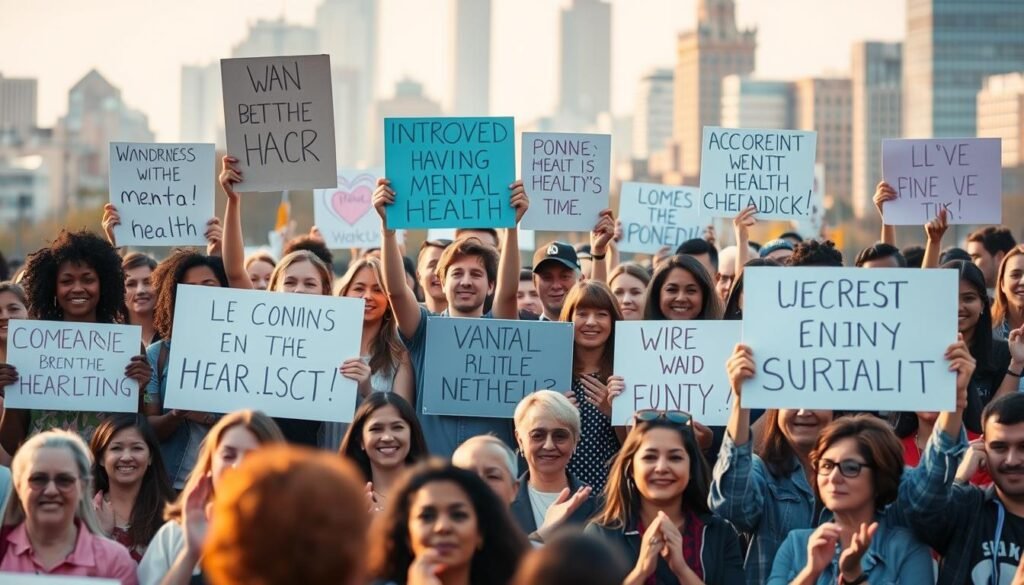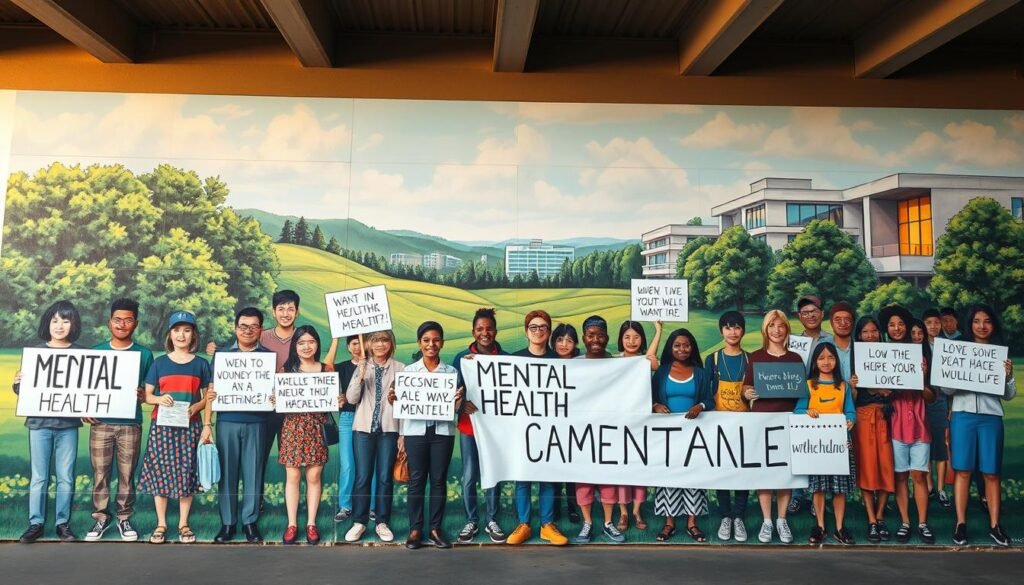Are we truly addressing the issue if we’re not openly discussing it? The conversation around mental wellness is often shrouded in silence. This leaves many to suffer in isolation.
Promoting mental health awareness is crucial. It helps create a society that supports, not stigmatizes, those with mental health issues. By encouraging open dialogue, we can make a place where people feel safe to seek help without fear of judgment.
To end stigma, we must first understand its roots and how it affects our communities. By doing so, we can develop effective strategies to combat it. This promotes a culture of understanding and support.
Key Takeaways
- Open discussions are key to promoting mental health awareness.
- Reducing stigma around mental health issues encourages individuals to seek help.
- A supportive community is crucial for those dealing with mental health challenges.
- Understanding the roots of stigma is the first step towards ending it.
- Creating a culture of support and understanding is vital for mental wellness.
Understanding Mental Health Awareness
Improving mental health outcomes is key. Mental health awareness is vital. It means recognizing the importance of mental wellness and understanding issues that affect it. It also involves taking steps to promote overall well-being.
Definition and Importance
Mental health awareness is about recognizing mental health issues. It’s about knowing how to seek help and support those affected. It’s crucial for mental health advocacy as it helps reduce stigma and builds a supportive community.
The role of mental health awareness is huge. It helps with early intervention and supports those with mental health issues. It also encourages open discussions about mental wellness.
Common Misconceptions
Despite efforts to educate, many misconceptions about mental health still exist. These misconceptions can make it hard to support those affected and can keep stigma alive.
| Misconception | Reality |
|---|---|
| Mental health issues are a sign of weakness. | Mental health issues can affect anyone, regardless of their strength or character. |
| People with mental health issues are violent or dangerous. | The vast majority of people with mental health issues are not violent and are more likely to be victims of violence. |
| Mental health issues are rare. | Mental health issues are more common than many realize, affecting a significant portion of the population at some point in their lives. |
The Role of Education
Education is key in promoting mental health education. By adding mental health education to school curricula and community programs, we can better understand mental health issues. This helps reduce stigma.
Good mental health education should give accurate info, promote empathy, and encourage seeking help. This way, we can build a supportive environment for open mental health discussions.
The Impact of Stigma on Mental Health
The stigma around mental health issues affects both individuals and communities. It makes it hard to promote mental wellness. Stigma can change how people see themselves and how others see them.
Social Stigma vs. Self-Stigma
Social stigma is when society has negative views of people with mental health issues. This can lead to discrimination and make it tough for people to get help. Self-stigma happens when people believe these negative views about themselves, leading to shame and low self-esteem.
Understanding the difference between social and self-stigma is crucial for developing targeted interventions to reduce mental health stigma.
Effects on Individuals
Stigma can have severe effects on individuals. It can lower self-esteem, lead to social isolation, and make people less likely to seek help. When people fear judgment, they often don’t get the support they need.
Creating a supportive environment where people feel safe talking about their mental health is key to reducing these effects.
Consequences for Communities
Stigma also affects communities, creating a culture of silence around mental health. This makes it hard for communities to promote mental wellness and provide the right resources.
- Reduced community engagement and support for mental health initiatives
- Increased prevalence of mental health issues due to untreated conditions
- Perpetuation of misconceptions and stereotypes about mental illness
By tackling stigma, communities can work towards a more supportive and inclusive place. This allows people to openly discuss their mental health.
The Need for Open Conversations
Talking openly about mental health is key to understanding and empathy. It helps us build a society that supports and doesn’t judge. By discussing mental wellness, we move towards a better, more open world.
Benefits of Discussing Mental Wellness
Talking about mental wellness has many benefits. It reduces stigma and brings people together. Open conversations increase awareness and understanding. This makes it easier for people to ask for help when they need it.
Also, discussing mental health helps people find ways to cope. It lets them support others too. Sharing experiences and advice helps everyone grow and learn together.
Creating Safe Spaces
Safe spaces are vital for mental health talks. These can be in-person, like support groups, or online. They’re places where people can share without fear of judgment.
To make these spaces, we need clear rules. These rules should promote respect and keep things confidential. This way, everyone feels heard and understood.
Encouraging Vulnerability
Encouraging people to be vulnerable is important. When they feel safe, they’re more likely to share their struggles. This builds deeper connections and stronger relationships.
Vulnerability leads to deeper connections. It helps us create a culture that values honesty and openness.
Role of Media in Mental Health Awareness
The media has a big impact on how we see mental health. It can either add to stigma or help spread awareness. How mental health is shown in the media shapes our views and understanding of it.
Positive Representation in Media
When media shows mental health in a good light, it helps a lot. It makes talking about mental health seem normal and builds empathy. For example, movies and TV shows that show real mental health struggles can help us understand better.
Media can also share stories of people who have beaten mental health problems. These stories give hope and inspire others. By talking openly about mental health, media can help break down barriers and create a more open society.
The Impact of Social Media
Social media is a big place for mental health talks. Many people and groups use it to share info, support each other, and raise awareness. But, it can also spread bad ideas or make people feel bad about themselves.
But, social media can also be a place for connection and building communities. If used right, it can help spread mental health awareness and fight stigma. Campaigns and efforts on social media can reach lots of people, starting important conversations and offering help.
Responsible Reporting Techniques
Good reporting on mental health means avoiding drama and making sure the facts are right. Journalists should use careful language, avoiding words that make people feel bad. They should focus on the real people behind the stories.
By reporting responsibly, media can help us all talk more clearly about mental health. This can help end stigma and make us all understand better.
Personal Stories: Breaking the Silence
Sharing personal stories about mental health is key to starting open talks. These stories help people feel less alone and more ready to share their own battles.
Testimonials from Individuals
People who have faced mental health issues share powerful stories. They talk about their fights and wins. For example, Drew Barrymore and Catherine Zeta-Jones have talked about their struggles with depression and bipolar disorder. Their stories make mental health more relatable.
These stories can motivate others to seek help. They also show how crucial support systems are in recovery. Loved ones play a big role in helping someone get better.
Influencers and Public Figures
Influencers and famous people have a big chance to spread mental health awareness. When they share their stories, it can really make a difference. For instance, Prince William has talked openly about his mental health. He aims to reduce the stigma around mental illness.
- Influencers can help make mental health talks normal.
- Public figures can promote mental health resources on their platforms.
- Their stories can encourage others to talk about their mental health.
The Power of Vulnerability
Being open about mental health is very empowering. It helps the person sharing and inspires others to do the same. As
“The most courageous act is still to think for yourself. Aloud.”
by Coco Chanel, being vulnerable can break down barriers. It helps build a supportive community.
Vulnerability connects people deeply, creating a sense of community. By embracing it, we can build a society that supports mental health better. It will be a place where judgment is less common.
Mental Health Advocacy Groups
Mental health advocacy groups are key in raising awareness and support across the United States. They work hard to keep mental health a top priority. This ensures it stays on the national agenda.
Notable Organizations
Many organizations lead the way in mental health advocacy. The National Alliance on Mental Illness (NAMI) is a big name. It offers support, education, and advocacy for those affected by mental illness.
Another important group is the Mental Health America. It promotes mental health through advocacy, education, and research.

Campaigns and Initiatives
These groups start many campaigns and initiatives to raise awareness. For example, NAMI’s StigmaFree campaign works to end stigma around mental illness. It encourages people to talk openly about it.
Mental Health America’s 2022 Mental Health for All initiative is another example. It aims to make sure everyone gets the mental health care they need.
How to Get Involved
It’s easy to get involved in mental health advocacy. You can volunteer with local groups, join fundraising events, or share awareness on social media. By supporting mental health resources and support mental health initiatives, we can all help create a more supportive community.
Barriers to Discussing Mental Health
Many things make it hard to talk about mental health. Despite more awareness and efforts to reduce mental health stigma, big challenges still exist. Knowing these barriers is key to making a space where people feel safe talking about their mental health.
Fear of Judgment
Fear of being judged is a big reason people don’t talk about mental health. This fear comes from how society views mental health issues. People might think they’re failing, not sick. So, they’re scared to share their struggles, worried they’ll be judged or pushed away.
Normalizing mental health discussions can help. By making it okay to talk about mental health without shame, we can get more people to seek help and support.
Cultural Influences
Culture also affects how we see mental health. Different cultures have different comfort levels when talking about mental health. For example, in some places, mental illness is seen as a weakness, while in others, it’s recognized as needing medical help.
It’s important to understand and respect these cultural differences. This helps us find ways to promote mental health awareness in all kinds of communities.
Lack of Resources
Not having enough resources is another big problem. Many places don’t have enough mental health professionals, support groups, or educational materials. This makes it hard for people to get the help they need, making things worse.
We need to tackle this issue in many ways. We should increase funding for mental health services, offer online resources, and train more professionals. By making more resources available, we can help create a supportive space for talking about mental health.
Strategies to Encourage Dialogue
To break the silence on mental health, we need good strategies for talking openly. Creating a space where people feel safe to share their mental health is key. This helps build a supportive community.
Promoting Open-Ended Questions
Asking open-ended questions is a great way to start conversations. These questions let people dive deep into their thoughts and feelings. They help promote mental health education and understanding.
Instead of “Are you okay?”, ask “How are you feeling today?” or “What’s been on your mind lately?” These questions show you care and can lead to deep talks about mental wellness.
Active Listening Techniques
Active listening is vital for mental health talks. It means really listening to what someone says, getting their point, and responding well. This makes a safe space for people to talk mental wellness without fear.
Good listening skills include eye contact, nodding, and not interrupting. Paraphrasing or summarizing what someone says shows you’re really listening and care about the conversation.
Language Matters: Choosing Words Wisely
The words we choose when talking about mental health matter a lot. Using the right words helps avoid making people uncomfortable. Using non-stigmatizing language makes the conversation more welcoming.
For example, saying “person with a mental illness” instead of “mentally ill person” is better. Being careful with our words encourages honest talks about mental wellness.
Policies Supporting Mental Health Awareness
Effective policies are key for mental health awareness in the U.S. They shape how we address mental health and make resources more available.
Legislative Changes in the U.S.
Recently, there have been big changes in laws to help mental health. The 21st Century Cures Act has funded mental health programs and research. It helps meet the mental health needs of people.
States are also making changes. Some require mental health education in schools. Others have made Medicaid cover more mental health services.
| State | Legislation/Program | Description |
|---|---|---|
| California | Mental Health Services Act | Provides funding for mental health services through a tax on high-income individuals. |
| New York | Mental Health Parity Law | Ensures that mental health services are covered by insurance to the same extent as physical health services. |
| Texas | School Mental Health Programs | Initiatives aimed at improving mental health support in schools. |
Importance of Workplace Policies
Workplace policies are crucial for employee mental health. Companies are now focusing on creating supportive work environments. They offer mental health days, counseling services, and encourage talking about mental health.
Good workplace policies help employees and make the workplace better. They reduce absenteeism, improve retention, and boost well-being.

Funding for Mental Health Programs
Funding is vital for mental health programs. Government, grants, and donations are key. They support services, research, and awareness.
Groups like Mental Health America are important in getting funding. They help ensure programs are supported and work well.
By backing policies that fund mental health, we can create a society that values mental health. We can provide the resources needed for those in need.
Mental Health Education in Schools
Mental health education in schools is key to the well-being of future generations. Schools can teach students to handle life’s challenges by adding mental health to the curriculum. This gives them the knowledge and skills they need.
It’s important to address mental health issues early in students. Schools can spot and support students with mental health problems early. This can prevent bigger issues later on.
Importance of Early Intervention
Early help with mental health can greatly improve a student’s life. Schools that focus on mental health education create a supportive place. This encourages students to ask for help when they need it.
Some key benefits of early intervention include:
- Improved academic performance
- Better social relationships
- Enhanced overall well-being
- Reduced risk of severe mental health issues
Curriculum Suggestions
Creating a good mental health curriculum needs a wide approach. It should include:
| Curriculum Component | Description | Benefits |
|---|---|---|
| Mental Health Literacy | Educating students about different mental health conditions, their symptoms, and treatment options. | Reduces stigma, promotes understanding |
| Coping Skills Training | Teaching students techniques to manage stress, anxiety, and other mental health challenges. | Enhances resilience, improves mental well-being |
| Support Systems | Informing students about available resources and support systems within the school and community. | Encourages help-seeking behavior |
Role of Educators
Educators are crucial in teaching mental health. They can help students feel safe talking about their mental health. This is because teachers know the signs of mental health issues and support their students well.
Key strategies for educators include:
- Creating a safe and non-judgmental space for discussions
- Being approachable and available to students
- Collaborating with mental health professionals to provide comprehensive support
Together, educators and mental health professionals can promote mental health education. They help end stigma around mental health issues.
The Workplace and Mental Wellness
Creating a supportive work environment is key for employee mental health. Companies are focusing more on mental health to boost productivity and happiness. They’re starting to see the value in mental health initiatives.
Cultivating a Supportive Culture
A supportive workplace culture encourages talking about mental health. This reduces stigma and makes the work environment healthier. It’s about having policies that support mental wellness, like flexible hours and mental health resources.
Employers can also support a culture by offering employee assistance programs (EAPs). These programs include counseling, stress management workshops, and more. They help employees manage their mental health.
Mental Health Days and Benefits
Offering mental health days is a great way to support mental health at work. Giving employees time off to focus on their mental health can reduce burnout. It also improves productivity.
As
“Mental health is just as important as physical health, and giving employees the time and resources to prioritize it is crucial.”
said a well-known mental health advocate. They stress the importance of mental health days.
Leadership Training
Training leaders to understand and support mental health is crucial. Leadership training programs teach managers to create a supportive environment. They learn to identify and support mental health issues early on.
- Recognizing signs of mental health issues
- Creating a safe space for discussions
- Referring employees to mental health resources
By investing in leadership training, companies can ensure their managers support employee mental health. This creates a more positive and productive work environment.
The Role of Families in Mental Health
Families are key in supporting mental health. The family environment can greatly affect a person’s mental well-being. A supportive family gives a sense of security and belonging, which is vital for good mental health.
Supporting Each Other
Families can support each other by creating a safe space to talk about feelings and struggles. This means being understanding, empathetic, and not judging. By doing this, families can help reduce mental health stigma.
To support each other well, families should:
- Practice active listening
- Encourage open conversations about mental health
- Be aware of the signs of mental health issues
- Seek professional help when needed
Encouraging Healthy Discussions
Creating a safe space for healthy discussions is important. This means promoting a culture of openness and understanding. Families should aim to:
- Use non-stigmatizing language when discussing mental health
- Avoid making assumptions about mental health conditions
- Focus on the individual, not the condition
The National Alliance on Mental Illness (NAMI) says, “families can play a critical role in the recovery process by providing emotional support and helping their loved ones navigate the healthcare system.”
“The family is the test of freedom; because the family is the only thing that the free man makes for himself and by himself.” – Gilbert K. Chesterton
Resources for Families
There are many resources to help families support mental wellness and reduce stigma. These include:
| Resource | Description | Benefit |
|---|---|---|
| NAMI | National Alliance on Mental Illness | Provides education, support, and advocacy |
| Mental Health America | Offers mental health screening tools and resources | Helps identify mental health issues early |
| Local Support Groups | Face-to-face support for families and individuals | Fosters a sense of community and connection |
By using these resources and keeping an open and supportive environment, families can greatly help in promoting mental wellness and reducing stigma.
The Intersection of Mental Health and Physical Health
Healthcare needs a complete approach that looks at both mind and body. This shows how important it is to care for both to be well.
Understanding the Connection
There’s a strong link between mental and physical health. People with mental health issues often face physical problems like diabetes and heart disease. On the other hand, those with physical health issues might also struggle with mental health, like depression and anxiety.
Mental health awareness is key to spotting early signs of mental health issues and their effects on physical health. By pushing for mental health advocacy, we support a healthcare system that looks at both mental and physical health.
“The mind and body are not separate entities; they are intimately connected, and the health of one cannot be achieved without the health of the other.”
Integrated Care Approaches
Integrated care models that mix mental and physical health services are gaining favor. These models help understand a patient’s health better and lead to more effective treatments.
| Benefits of Integrated Care | Description |
|---|---|
| Holistic Treatment Plans | Addresses both mental and physical health needs |
| Improved Patient Outcomes | Enhanced overall well-being and quality of life |
| Reduced Healthcare Costs | By minimizing the need for separate treatments and hospitalizations |
Holistic Wellness Strategies
Using holistic wellness strategies can greatly improve both mental and physical health. This includes mindfulness, regular exercise, and eating well.
By grasping the connection between mental and physical health, and by using integrated care and holistic wellness, we can foster a culture of wellness. This improves life quality for individuals and communities.
Digital Tools and Resources
The digital age has changed how we handle mental health. Now, we have many tools and resources at our fingertips.
These digital tools make it easier to get support and manage our mental health. They help us stay well.
Apps for Mental Wellness
Mental health apps are getting more popular. They offer mood tracking, meditation, and mindfulness exercises.
- Mood Tracking Apps: Let users track their emotions over time. This helps spot patterns and triggers.
- Meditation and Mindfulness Apps: Offer guided sessions to lower stress and improve focus.
Apps like Headspace and Calm are well-known for helping people relax and focus.
Online Therapy Platforms
Online therapy platforms are a convenient way to get mental health support.
These platforms connect users with licensed therapists. They offer video sessions and messaging services.
- Convenience: Allows therapy from home.
- Accessibility: Makes mental health services available to more people.
Community Forums and Support Groups
Online and offline forums and support groups are key for mental health. They provide a sense of community and understanding.
These platforms are safe spaces for sharing, support, and connecting with others facing similar challenges.
- Online Forums: Websites and social media groups for mental health support.
- Support Groups: Groups that meet regularly for mutual support.
Using these digital tools and resources helps us manage our mental health proactively.
The Future of Mental Health Awareness
Mental health awareness is becoming more important as society changes. We’re working hard to reduce stigma around mental health. This helps create a supportive environment for mental health initiatives.
Emerging Trends
New trends include adding mental health services to regular doctor visits. Telehealth is also growing, making help easier to get. Technology, like mental health apps and online therapy, is reaching more people.
Leveraging Technology
Technology is changing how we talk about mental health. It helps us connect, get support, and learn more. Digital tools are making advocacy stronger, helping mental health become a normal topic.
Advocacy Goals
Our future goals include pushing for policies that help mental health. We also want to keep talking openly to fight stigma. Together, we can make mental wellness a top priority and offer full support to those who need it.



